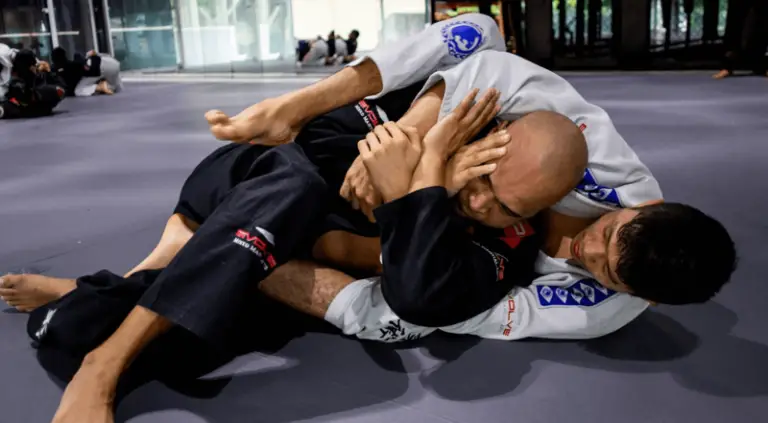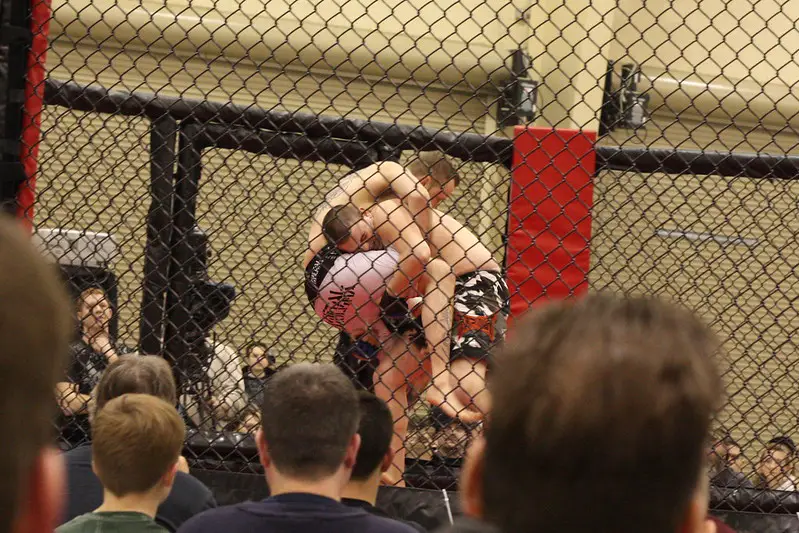BJJ is one of the most popular martial art, practiced all around the world. Yet, many individuals looking to enrol in BJJ classes wonder — Is BJJ good for Beginners?
BJJ is good for beginners as the classes are adaptable and split into different levels. Thus, the learning program and intensity are adapted to a beginner level so that students do not get overwhelmed at the start.
The classes are safe, dynamic, and fun, and allow you to train in a positive and judgment-free environment.
Let’s further explore how good is BJJ for beginners and what you may expect in classes.
Is BJJ Good For Beginners?
The main reasons are the safety and adaptability of training. The injury rate is low among beginners, and they can all start and progress regardless of fitness level or age.
Here is a detailed explanation of why BJJ is great for beginners:
Supportive community
The BJJ community is renowned for its supportive atmosphere. Beginners benefit from this culture that values collaboration over competition in the gym. It allows them to train in a judgment-free environment where there are no mistakes — only lessons to be learned.
Most academies have a sign at the front doors that says “check your ego” for a good reason. Each training group acts like a family that supports and helps each other toward achieving individual goals.
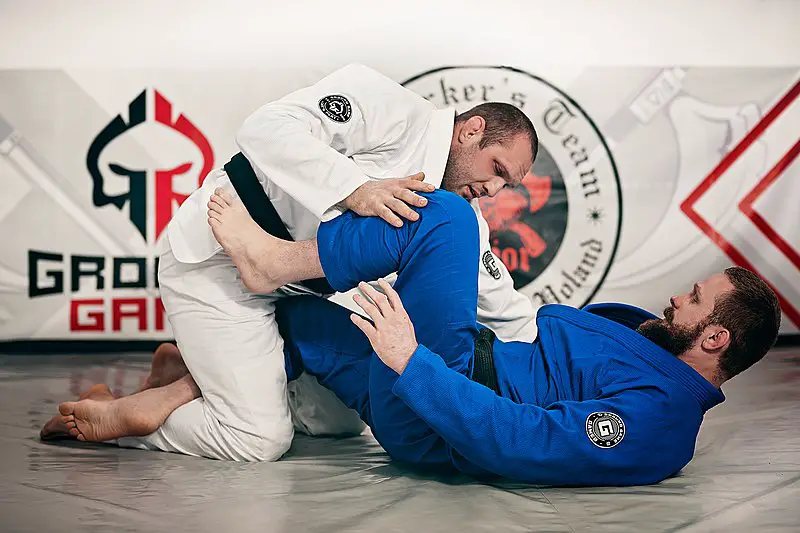
That’s why you can often see senior students helping newcomers, offering them tips, and help overcome certain challenges. This positive environment fosters a sense of camaraderie, making the learning journey more enjoyable and less intimidating
Adaptable training program
The learning curriculum is split into different levels so you will begin according to your fitness level and preferred intensity. You won’t get overwhelmed at the start but rather progress step by step in a smooth learning curve.
BJJ training allows beginners to learn at their own pace. In classes, instructors often tailor guidance to individual needs, making it adaptable for various skill levels and physical abilities. You will focus on mastering the moves and position without the pressure of having to do it fast.
Technique Over Strength
BJJ) is great for beginners because it’s not about being strong or fast. The concept emphasizes technique and leverage rather than pure muscle power. It’s like a puzzle where you learn how to move and position your body to outsmart your opponent.
It doesn’t matter if you are obese, skinny, weak, or old, the classes are adaptable to people of all ages, genders, and fitness levels. You will train in a group that shares a similar level of proficiency, and under the close guidance of multiple instructors.
The system itself is designed to enable a physically inferior individual to beat a larger opponent. So even if you are not strong, that doesn’t stop you from learning and progressing. Although being strong enhances your game, it’s not a decisive factor among beginners.
Safer Than Most Other Martial Arts
Jiu-Jitsu doesn’t involve any striking with punches and kicks. This on its own makes it safer than most other martial arts, notably for beginners. The injury rate of 15 per 1000 exposures is lower than in, let’s say MMA where it is 28 per 1000 exposures.
Still, BJJ includes intense physical contact, hard falls, and pulling on the joints. Thus, minor injuries and common, and your body will hurt. However, there is a greater chance you will get hurt training in other arts than in jiu-jitsu.
The reason is simple — skill is more important than power. The entire approach to “fighting” is less aggressive and intense and it teaches students to rely more on their mind than sheer power.
Fun and Playful
BJJ is great for beginners mainly because it is safe and the fun begins right from the start. In most academies, students start rolling with their partner in the first week of training, often on their first day. Beginners love this approach as it enables them to jump right into action.
Even though they probably don’t have a clue of what they are doing — it doesn’t matter. The whole point is to allow beginners to feel what BJJ is all about, and get rid of anxiety and pressure.
Of course, all of them get specific tasks and moves they should concentrate on. But overall, it doesn’t matter if you have a hard time executing these moves right away. The art of jiu-jitsu is all about practice and repetition. Trust the process, you will improve with time.
Why Brazilian Jiu-Jitsu is Hard For Beginners?
Most BJJ beginners find the opening months hard because their bodies are not physically prepared for unnatural movements. They also find rolls exhausting due to their lack of endurance and may have a hard time recovering between the sessions and other reasons such as:
- Not progressing fast enough
BJJ is not beginner-friendly because you must spend months training hard without feeling any progress. During this time, beginners get submitted hundreds of times and may reach the breaking point. However, this is just a part of the learning process and all athletes have been there.
Don’t set high expectations. Always remember that it takes between 10–15 years to reach a black belt in jiu-jitsu. You are just starting out.
- Lack of strength and stamina
BJJ requires a specific type of functional strength and endurance. Even if you are athletic, your body will still need quite some time to adapt to hard falls, pulling on the joints, and rolling while carrying your partner’s weight on top.
Though it may look playful, rolls are exhausting and most beginners burn out after a few minutes. Still, do not get discouraged. Trust the process, work hard, and your body will adapt.
- Pain and soreness
Hard falls, pulling on the joints, putting the body in unnatural positions, all of this puts a lot of stress on the body. Most BJJ beginners have a hard time dealing with the chronic muscle soreness that comes with training and recovering between sessions.
As a beginner, you will mainly work on drilling the basic movements such as escapes, and play a bit with submission holds.
BJJ Beginner Tips
- Consistency is key
At the beginning, be sure to show up to the classes at least three or four times a week. This is optimal as it allows you to learn at a smooth pace without stressing your mind and body. And, it also gives your body and mind enough time to recover and regain energy.
BJJ skills improve with repetition and time spent on the mats. So commit to consistent training to build muscle memory and grasp fundamental techniques. It will pay off in the long run.
- Focus on Basics
As a white belt, master the core moves. Strong foundations in escapes, submissions, and positional control lay the groundwork for advanced techniques that come into play later. Don’t rush; take time to understand and perfect the basics, and improve muscle memory.
Rushing only leads to the development of bad habits that are almost impossible to correct later.
- Keep the ego low
BJJ is hard for beginners because you must eat many humble pies. In the opening months, you will often feel like a practice dummy for senior practitioners. They will submit you hundreds of times and throw around which may feel discouraging.
Though you might struggle to stay motivated, embrace the learning process, and your skills will evolve over time.
- Always tap on time
The beauty of BJJ is that you can always tap out whenever you feel any pain or discomfort. Just a small tap can prevent injuries and enable you to do it again and focus on correcting mistakes. Not tapping on time, on the other side, increases the risk of injuries by a large margin.
- Ask Questions
Instructors and higher-ranked teammates are valuable resources. Don’t hesitate to ask questions about techniques or seek feedback. In the end, BJJ is a communal learning experience, and others are often eager to help.
What Will You Learn In The First Week of BJJ Training?
In the beginning, you’ll focus on basic moves like escapes and submissions. These are like your building blocks. As you practice, you start to understand how your body works during the rolls, and what jiu-jitsu is all about skillwize.
Your body and mind are yet to adapt to grappling and it’s normal to feel lost and confused. It takes time for you to improve coordination, and spatial awareness, and become more flexible.
Apart from the basics, the emphasis of the opening months will be on getting your body in shape. This includes improving strength, endurance, and range of motion with pre and post-workout stretches. Improving the range of motion is crucial because this enables you to perform with better form and learn at a faster rate.
Is BJJ Dangerous For Beginners?
BJJ includes physical contact right from day 1. As such, it carries a certain risk of injuries but its danger level for beginners is generally low with proper training and supervision. Its emphasis on technique rather than power along with safety measures makes beginner training safe and fun.
However, injuries can still occur, typically minor ones like bruises or strains. Chronic muscle soreness is mandatory among BJJ beginners.
In training, beginners are usually paired with more experienced partners to ensure a safer learning environment. They are also taught to always time whenever they feel any pain or discomfort, as well as to communicate about their limitations, fears, or discomfort.
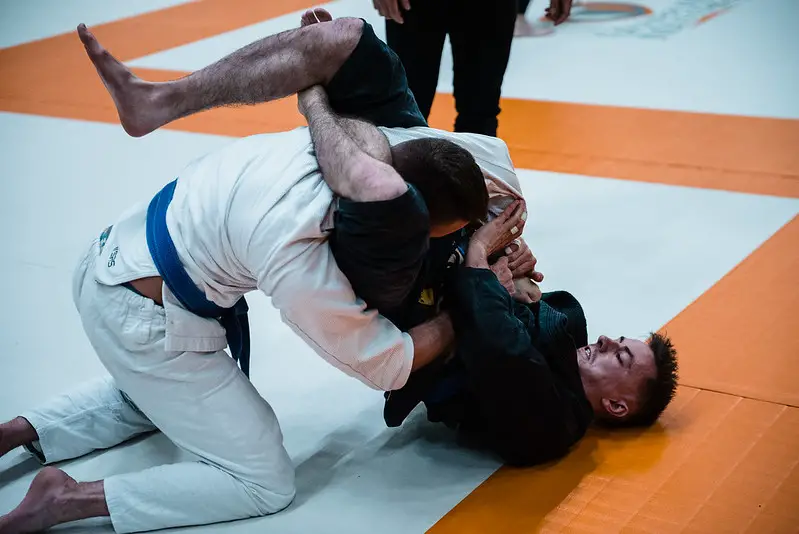
The majority of injuries happen by accident due to the lack of supervision, improper execution of techniques, and not tapping on time. For instance, beginners are yet to learn how to fall or escape without muscling their way out of the bad position.
As a result, they might fall at a bad angle, or try to muscle their way out of specific positions when they shouldn’t.
What Are The Most Common Injuries in BJJ?
While BJJ is generally considered a safe sport, injuries can still occur. The most common injuries in BJJ include:
- Joint Sprains and Strains. BJJ involves a lot of joint manipulation, and practitioners often experience sprains or strains in joints, particularly in the fingers, wrists, elbows, shoulders, knees, and ankles.
- Muscle Strains. Overexertion or improper warm-up can lead to muscle strains. Common areas for muscle strains include the neck, back, and various leg muscles.
- Bruises and Contusions. Due to the close contact and groundwork in BJJ, participants often experience bruises and contusions. These can occur on almost any part of the body.
- Cauliflower Ear. Repeated friction and trauma to the ears can lead to hematoma, causing the ear to become deformed and swollen, a condition known as cauliflower ear.
- Dislocations. Joint dislocations, especially of the shoulders and fingers, can occur during intense grappling sessions or competitions.
- Ligament Injuries. Ligament injuries, such as ACL or MCL tears, can occur when there is excessive twisting or pressure on the joints during grappling.
- Fractures. While less common, fractures can happen, especially in situations where there is intense force or awkward landing positions.
- Hyperextensions. Submission holds, if applied too forcefully, can lead to hyperextension injuries, particularly in the elbow joint.
- Neck Injuries. Improper technique or resistance during chokes and neck cranks can result in neck injuries, including strains and sprains.
- Back Injuries. Prolonged groundwork and dynamic movements can contribute to back injuries, such as strains or herniated discs.
How Long To Become Good At BJJ?
Most beginners make major progress when they earn a blue belt rank, which takes around 1–2 years of consistent training. The exact time is based on individual factors such as:
- Consistency
- Fitness level
- Individual dedication to the sport
- Previous martial arts background (Judokas learn much faster)
Achieving a purple belt, which represents a more advanced skill level, often takes another 2 to 4 years. Becoming proficient at BJJ and attaining a black belt typically takes a decade or more. In fact, reaching a black belt rank takes between 10 and 15 years on average.
So do not be obsessed with trying to become good at BJJ in a short time. It’s important to view BJJ as a long-term journey rather than a quick destination.
What Is The Best Age To Start Jiu-Jitsu?
Jiu-Jitsu can be enjoyed by individuals of various ages, and there isn’t a specific “best” age to start. Here are some considerations for different age groups:
Children (5-12 years old)
Many Jiu-Jitsu academies offer classes specifically designed for children. Starting Jiu-Jitsu at a young age can help develop coordination, balance, discipline, and a sense of respect for others. However, it’s crucial to find an academy with experienced instructors who understand how to teach children in a safe and enjoyable manner.
Teens (13-17 years old)
Adolescents can benefit greatly from Jiu-Jitsu, as it promotes physical fitness, self-discipline, and self-defense skills. Teenagers are often capable of grasping more complex techniques and concepts, making it an opportune time to start training.
Adults (18 years and older)
Adults can start Jiu-Jitsu at any age. Many practitioners begin as adults and still progress to high levels of skill and proficiency. Starting Jiu-Jitsu later in life can bring various physical and mental benefits, such as improved fitness, stress relief, and increased self-confidence.
Seniors (50 years and older)
While starting Jiu-Jitsu at an older age may present some physical challenges, many individuals have successfully taken up the sport later in life. It’s essential to choose an academy that emphasizes a safe and controlled learning environment and to communicate with instructors about any health concerns.
Gi or No-Gi BJJ For Beginners?
Both styles are good for BJJ beginners. An individual can start their journey in a gi style (traditional Jiu-Jitsu with a uniform) or no-gi style (without the traditional uniform) without any limitations.
Which one is better is based on many individual factors. This includes the style you prefer or long-term goals. Here are some of the key points of both styles.
Starting with Gi:
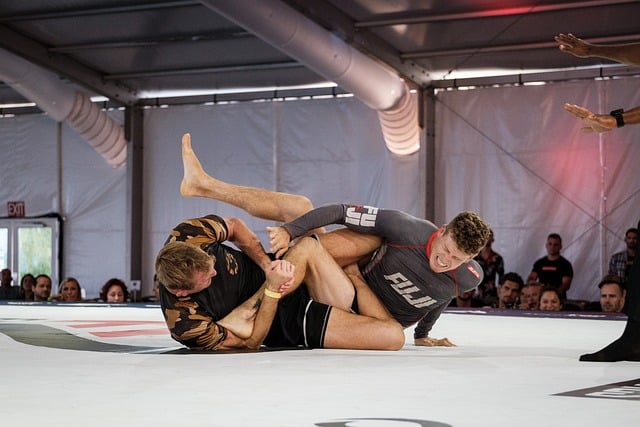
- Grip Control and Technique: The gi provides numerous grips and handles that allow for more control and manipulation of your opponent. This can help beginners develop a strong understanding of technique and leverage.
- Self-Defense: The gi can be used for self-defense, as it simulates clothing, collars, and sleeves, which may be present in real-world situations.
- Traditional Aspect: Training with the gi is considered more traditional and is often seen as an essential part of the Jiu-Jitsu experience. It connects practitioners to the roots of the art.
- Patience and Strategy: Gi Jiu-Jitsu often requires more patience and strategic thinking due to the increased possibilities for control and submission.
Starting with No-Gi:
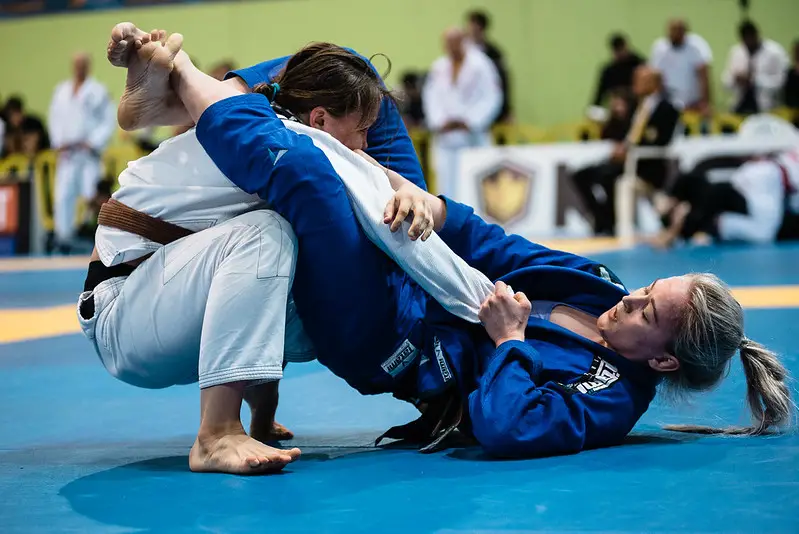
- Faster Pace: No-gi tends to be faster-paced and more dynamic, which can be appealing for those who enjoy a quicker style of grappling.
- Focus on Body Movement: No-gi emphasizes body movement, agility, and faster transitions, which can be beneficial for developing athleticism and agility.
- Applicability to MMA: If your interest lies in mixed martial arts (MMA), starting with no-gi might be more relevant, as it closely resembles the grappling aspect of MMA.
- Less Equipment: No-gi requires less equipment, making it more accessible for beginners who might not want to invest in a gi right away.
- Ultimately, there is no right or wrong choice, and many practitioners train in both gi and no-gi over time.
Final Thoughts – Is BJJ Good For Beginners?
BJJ is an excellent option for beginners because of its structural training approach, safe teaching methods, and philosophy rooted in respect and positivity. Regardless of talent, fitness level, age or gender, anyone can join the classes and thanks to the adaptable learning curriculum, develop their own style.
Yes, BJJ beginners must be aware that the first opening months are hard. Coaches and training partners will put your ego and will to the test each time you step on the mats. But if you manage to set up the right mindset and accept this as a part of the learning process, you will stick with BJJ for the rest of your life. It will completely change every single physical and mental aspect of your life for the better.
How Effective is BJJ In MMA?
